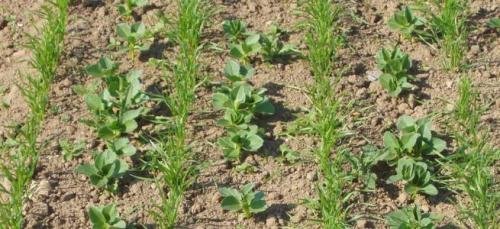New research shows potential in forgotten agricultural practices

The Food and Agriculture Organization of the United Nations made a projection that 108 million tons of synthetic mineral nitrogen fertilizer would be produced in 2020. In November 2019, the Danish government, entered into a political agreement limiting nitrogen emissions from Danish agricultural practices.
More or less on the same time, in a research article in the scientific journal Agronomy for Sustainable Development, researchers from Sweden’s Agricultural University and Professor Henrik Hauggaard-Nielsen from Roskilde University present research results which show that the agroecological practice of intercropping cereals and legumes can reduce the global consumption of nitrogen fertilizers with up to 26% and potentially reduce the amount of land needed to cultivate the crops with approximately 115 million hectares out of a total approximately 1,500 million hectares of global farmland, without reducing the total productivity.
Mineral nitrogen fertilizer or synthetic fertilizer, as it is also known, has played a large part in the development of the modern agricultural system with high yields and low food prices. Production of the fertilizer, however, requires a great deal of energy, which is typically sourced from fossil fuels. Nitrogen can moreover leach to the surrounding aquatic environments and is, due to nitrous oxide, one of the primary sources of greenhouse gas emissions from the global agricultural production.
The calculations in the research article are based on a theoretical scenario where all the legumes, such as soybeans, peas, beans, lentils, etc., in the current global agricultural systems are cultivated along with cereals such as barley, wheat, oats, etc., instead of the typical cultivation of these protein crops separately.
“Reducing the use of synthetic nitrogen fertilizer through intercropping will be an important step towards reducing the negative effects of agriculture on the environment, for instance in relation to the planetary boundaries for how much the world can handle in terms of nitrogen input and greenhouse gas emissions,” says Professor Henrik Hauggaard-Nielsen.
This is due to the legume plant’s ability to absorb atmospheric nitrogen via symbiosis with the soil bacteria, by the legume plants forming tubers wherein specific bacteria can convert atmospheric nitrogen to ammonia, which is delivered to the plant and in turn the plant can increase its growth irrespective of the soil’s nitrogen content.
The planetary boundaries were developed by researchers from Stockholm’s Resilience Centre and are used as a target for how much of the globe’s resources or environmental capital humanity can use.
Moreover, intercropping can also provide other potential advantages, such as increased yield stability, reduced issue with pests and weeds, which can lead to a reduced need for pesticide usage.
Intercropping is an old practice but point forward
Intercropping is defined as a cultivation practice, where two or more crops are cultivated simultaneously, which leads to a more effective utilisation of growth factors such as water, light and nutrients. This phenomenon also happens in nature where different plants and trees locate themselves in relation to how the growth factors are distributed. Prior to mechanisation and the rising use of synthetic fertilizer and pesticides around the 1950s, many farmers would simultaneously cultivate several crops on the same field to achieve a greater security for the year’s harvest yield. Due to other technological advances in agriculture and the development of society, intercropping is no longer a widespread practice.
The benefit of nature’s own regulatory mechanisms
Even though intercropping requires more land, compared to when the grain legume plants are cultivated alone, in order to produce the same amount of protein, the intercropping’s extra cereal yield will make a reduction in total land use.
Intercropping, as presumed in the researcher’s theoretical scenario, sets in motion a so-called agroecological intensification, which increases the total harvest yield per land unit, and contributes to the aforementioned approximately 115 million hectares of the current cereal cultivating land to be released and utilised for other crops, or reclaiming the land for nature to increase natural diversity in the general landscape. The analysis indicates that there is a great potential in using agroecological practices such as intercropping in the development of a more sustainable land use.
“With our research, we have shown how nature’s own regulatory mechanisms to a large degree can benefit the land use of the future. Our current focus in the research is an increased effort to involve skilled farmers in the development of these agroecological cultivation principals in order to not only achieve technical realisations but also insights into the social relations such as traditions, regulations and norms, which naturally are part of the development of the intercropping principals in modern mechanised farming,” says Henrik Hauggaard-Nielsen.
The research results have been presented in the research article with the title ‘Intercropping of grain legumes and cereals improve the use of soil N resources and reduces the requirement for synthetic fertilizer N: a global-scale analysis’, written by Professor Erik Steen Jensen and Associate Professor Georg Carlsson, both from Sweden’s Agricultural University and Professor Henrik Hauggaard-Nielsen from the Department of People and Technology at Roskilde University.